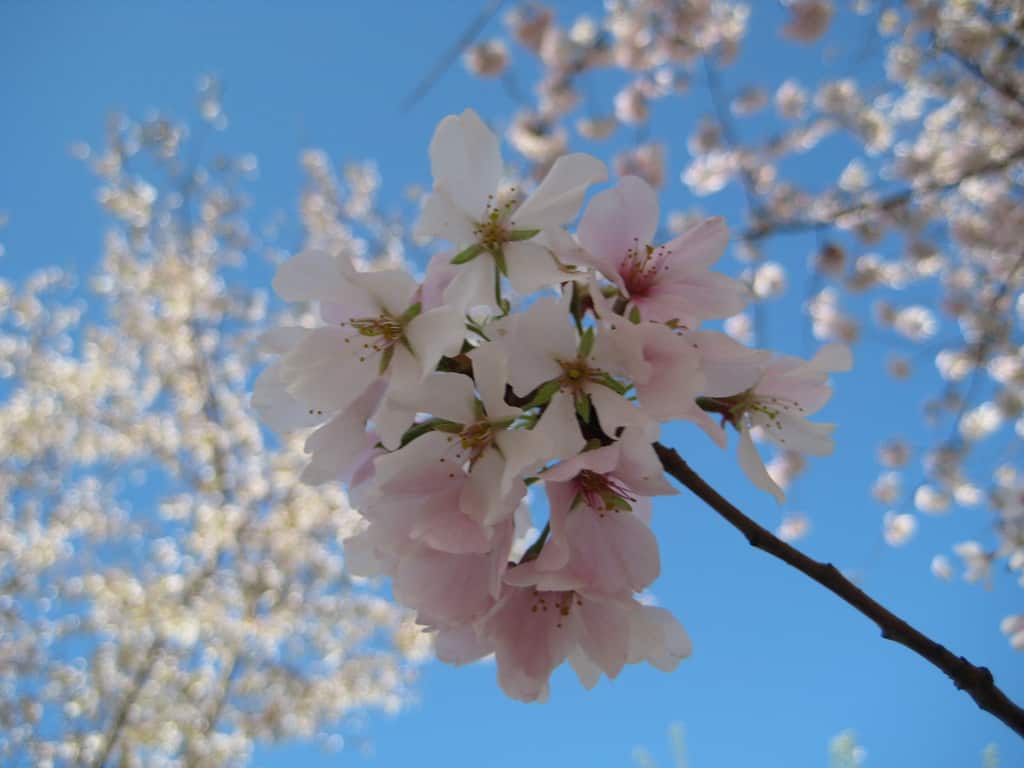 Photos: Creativecommons.org/Stephanie Clifford
Photos: Creativecommons.org/Stephanie Clifford
In 1912 the mayor of Tokyo city made a gift of Japanese cherry trees to the city of Washington to celebrate the growing friendship between Japan and the United States. Over the years, hundreds more trees have been given by the Japanese, and today, more than 100 years after the first gift, Washington still celebrates these beautiful blossoms in honour of the friendship that continues between the two countries.
The time frame of the Cherry Blossom Festival was chosen to cover the most likely time-period that the trees will be in bloom, but the exact date of the peak blossoming is up to Mother Nature. Every year in mid-March the National Park Service sends horticulturists to assess the trees, determine the size of the buds and check the upcoming weather expectations. Based on all these factors, the Park Service issues a “peak bloom forecast”, listing a range of dates that are expected to have the most blossoms on most of the trees. The trees are regularly reassessed and the date range adjusted as necessary. This year’s cold weather has pushed the peak bloom forecast far past the average date of March 31 to April 8-12, but there should still be plenty of blossoms to see if your vacation schedule is a bit before or after that time frame.

This year’s festival began on March 20 and it continues with weekend events for the next several weeks. March 29 will find the air around the Washington Monument filled with brightly coloured streamers as competitors and amateurs send their creations flying during the kite festival. Other events include CineMatsuri, which is produced by the Japan-America Society of Washington D.C., and the Cherry Blossom Soccer Tournament, which takes place on the Polo Fields on the National Mall.
On Sunday there is a special tram tour to visit the different trees. The Beyond the Tidal Basin Tram Tour is narrated by horticulturist David Kidwell-Slak, and it takes you through the National Arboretum where you will learn about research and individual species. The tour takes you to see mature trees that have grown from cuttings taken from the original trees planted over 100 years ago.
A Kimono Fundraiser is being held at the Mandarin oriental from April 2 to 4. Over 1,000 Kimono, Obi and Kimono accessories will be for sale to raise funds for the National Cherry Blossom Festival and the Japan America Society. Kimono are considered a work of art and browsing through the collection is a wonderful experience, even if you aren’t planning on taking one home.
If you have a taste for sake, the Grand Sake Tasting is held on April 3and features not only the top one per cent of sakes produced, but also the master brewers who make them. This elite event will let you taste sakes that are extremely rare, some only available for a few days a year, and give you the opportunity to purchase some of your favourites. Proceeds benefit the National Cherry Blossom Festival.
Saturday, April 5 is the last official day of the festival. Start the day with the 16thAnnual Cherry Blossom Freedom Walk, or watch the first day of the 48thAnnual Cherry Blossom Rugby Tournament between the U.S. and Canada. A Japanese quilting workshop will be teaching sashiko embroidery at the National Museum of Women in the Arts, and there will be outdoor Cherry Blossom Yoga near the Washington Monument.
A children’s cherry blossom event will be taking place in Alexandria that includes origami and a cherry blossom “hunt”. At the Library of Congress, Japanese Culture Day will be giving families the chance to learn about the country’s culture through reading, writing, origami and other activities. The Cherry Blossom Princesses will be on hand to make tiaras and the library will be open to explore.
The festival ends with fireworks, and the best place to see them is from the Southwest Waterfront. Plan on going early to choose your spot because there will live entertainment that starts at 1pm and continues until the fireworks begin.
Several notable events are being held after the official end of the festival. A 10-mile run will follow a course that takes the runners through the blossoming trees. The Official Japanese Stone Lantern Lighting Ceremony will take place at the 400-year-old lantern that was gifted to Washington D.C. in 1954. Since that date, the lantern is lit every year by the Cherry Blossom Princess. If you plan on staying longer, the Princesses will hold a luncheon on the 10th and the 2014 U.S. Cherry Blossom Queen will be crowned on the 11th. You can also look forward to Taiko drumming, the Japanese street festival, a big parade on the 12th and the closing concert will take place on the 13th.

Did you know?
- The first two cherry trees were planted by First Lady Helen Herron Taft and Viscountess Chinida, the wife of the Japanese ambassador.
- Park rangers provide special talks and tours during the Cherry Blossom Festival covering not only the trees, but also the memorials in the mall.
- There are many varieties of flowering cherries, but the National Mall predominantly features the Yoshina and Kwanzan varieties.
- You can hold a wedding under the cherry blossom trees, but it requires a Special Use Permit and you are restricted to certain areas.
- Adidas released a special “Cherry Blossom Edition Crazy 1” line of socks, hats and sneakers to celebrate this year’s festival.
Did you know? The Usuzumi variety of blossoming cherry that are planted in West Potomac Park are said to have been first planted in the 6th century by Japanese Emperor Keitai.


